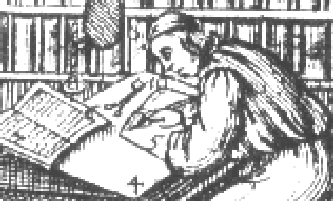
 |
Text Encoding Initiative |
The XML Version of the TEI GuidelinesAppendix C3. Introductory Note (May 1999) |
Up: Appendix C Prefatory Notes Previous: Appendix C2. Introductory Note (June 2001) Next: Appendix C4. Preface (April 1994)
|
Appendix C3. Introductory Note (May 1999) Appendix C3.1. Typographic corrections made Appendix C3.2. Specific changes in the DTD Appendix C3.3. Outstanding errors Introductory Note (March 2002) 2 A Gentle Introduction to XML 3 Structure of the TEI Document Type Definition 4 Languages and Character Sets 6 Elements Available in All TEI Documents 14 Linking, Segmentation, and Alignment 17 Certainty and Responsibility 18 Transcription of Primary Sources 21 Graphs, Networks, and Trees 22 Tables, Formulae, and Graphics 29 Modifying and Customizing the TEI DTD 32 Algorithm for Recognizing Canonical References 38 Sample Tag Set Documentation 39 Formal Grammar for the TEI-Interchange-Format Subset of SGML |
No work of the size and complexity of the TEI Guidelines could reasonably be expected to be error-free on publication, nor to remain long uncorrected. It has however taken rather longer than might have been anticipated to complete production of the present corrected reprint of the first edition, for which we present our apologies, both to the many individuals and institutions whose enthusiastic adoption and promotion of the TEI encoding scheme have ensured its continued survival in the rapidly changing world of digital scholarship, and also to the many helpfully critical users whose assiduous uncovering and reporting of our errors have made possible the present revision. At its first meeting in Bergen, in June 1996, the TEI Technical Review Committee (TRC) approved the setting up of a small working committee to oversee the production of a revised edition of the TEI Guidelines, to include corrections of as many as possible of the `corrigible errors' notified to the editors since publication of the first edition in May 1994, the bulk of which are summarized in a TEI working paper (TEI EDW67, available from the TEI website). During the spring of 1997, this TRC Core Subcommittee reviewed nearly 200 comments and proposals which the editors had collected from public debate and discussion over the preceding two years, and provided invaluable technical guidance in disposition of them. We are glad to take this opportunity of expressing our thanks to this subcommittee, whose members were Elli Mylonas, Dominic Dunlop, and David T. Barnard. The work of making the corrections and regenerating the text proceeded rather fitfully during 1998 and 1999, largely because of increasing demands on the editors' time from their other responsibilities. With the establishment of the new TEI Consortium, it is be hoped that maintenance of the Guidelines will be placed on a more secure footing. Some specific areas in which we anticipate future revisions being carried out are listed below. Appendix C3.1. Typographic corrections made
Appendix C3.2. Specific changes in the DTDA major goal of this revision was to avoid changes which might invalidate existing data, even where existing constructs seemed erroneous in retrospect. To that end, wherever changes have been made in content models for existing elements, they have as far as possible been made so that the DTD will now accept a superset of what was previously legal. Only one new element (<ab>) has been added. Where possible, a few content models have been changed in such a way as to facilitate conversion to XML, but XML compatibility is not a goal of this revision. Brief details of all changes made in the DTD follow:
A number of content models were changed with a view to easing the creation of an XML compatible version of the Guidelines. Specifically:
Appendix C3.3. Outstanding errorsA small number of other known problems remain uncorrected in this version and are briefly listed below. Please watch the TEI mailing list for announcements of their correction.
Our next priority however will be the production of a fully XML-compliant version of the TEI DTD, work on which is already well advanced. C.M. Sperberg McQueen and Lou Burnard, May 1999 |
Up: Appendix C Prefatory Notes Previous: Appendix C2. Introductory Note (June 2001) Next: Appendix C4. Preface (April 1994)
edited by C M Sperberg-McQueen and Lou Burnard.
Copyright TEI Consortium 2002